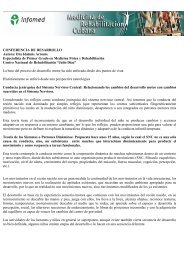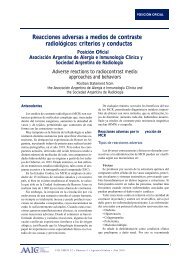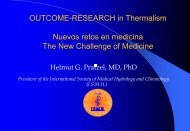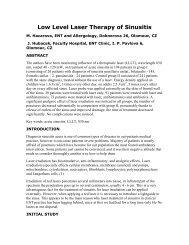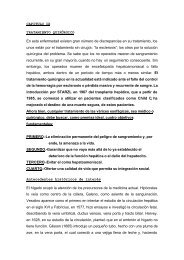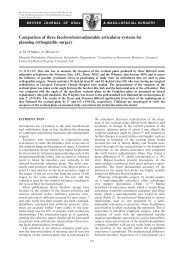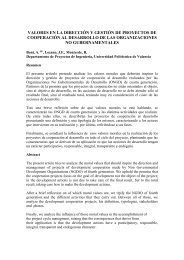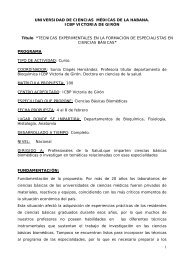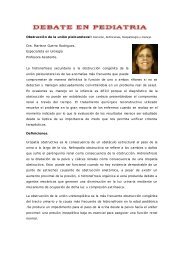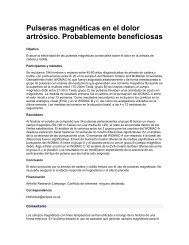pharmacology of medicinal plants and natural products
pharmacology of medicinal plants and natural products
pharmacology of medicinal plants and natural products
Create successful ePaper yourself
Turn your PDF publications into a flip-book with our unique Google optimized e-Paper software.
MEDICINAL PLANTS (NATURAL PRDUCTS)<br />
S95<br />
Ayurveda, showed significant protection against<br />
cumene hydroperoxide induced lipid peroxidation <strong>and</strong><br />
lowered reduced glutathione <strong>and</strong> superoxide<br />
dismutase levels in rat liver homogenate. It also significantly<br />
reduced malondealdehyde (MDA) levels. No<br />
alterations in biochemical <strong>and</strong> histopathological parameters<br />
was noted. The results thus suggested that<br />
tamra bhasma is a potent anti-oxidant drug <strong>and</strong> can<br />
be used in the management <strong>of</strong> lipid peroxidation 157 .<br />
Similarly, S<strong>and</strong>hika, an Ayurvedic drug was evaluated<br />
in vitro using the same model (cumene<br />
hydroperoxide) <strong>and</strong> showed significant antioxidant<br />
activity 46 .<br />
13.3. Iron induced<br />
Anti-peroxidative property <strong>of</strong> Nardostachys<br />
jatamanasi (Jatamanasi) was tested in vitro by using<br />
iron induced lipid peroxidation in rat liver homogenate.<br />
The degree <strong>of</strong> peroxidation was quantitated by<br />
thiobarbituric acid reactive substance (TBARS) content.<br />
Both the hexane <strong>and</strong> alcoholic extracts provided<br />
protection against lipid peroxidation (the hexane fraction<br />
was more potent) suggesting that the plant does<br />
have anti-oxidant activity 158 .<br />
Rubiadin, a dihydroxy anthraquinone, isolated from<br />
alcoholic extract <strong>of</strong> Rubia cordifolia (manjistha) demonstrated<br />
significant anti-oxidant property as it prevented<br />
lipid peroxidation induced by FeSO 4<br />
<strong>and</strong><br />
t-butylhydroperoxide (t-BHP) in a dose dependent<br />
manner. The percent inhibition was more in the case<br />
<strong>of</strong> Fe 2+ induced lipid peroxidation. The anti-oxidant<br />
property <strong>of</strong> the preparation has been found to be<br />
better than that <strong>of</strong> EDTA, mannitol, Vitamin E <strong>and</strong> p-<br />
benzoquinone 159 .<br />
The potential <strong>of</strong> Bacopa monniera as an antioxidant<br />
was studied by Tripathi et al, 160 . The effect <strong>of</strong> the<br />
alcoholic <strong>and</strong> hexane fractions <strong>of</strong> Bacopa monniera<br />
on FeSO 4<br />
<strong>and</strong> cumene hydroperoxide induced lipid<br />
peroxidation was studied. The alcoholic fraction<br />
showed greater protection against both that inducers<br />
<strong>and</strong> the results were comparable to known antioxidants<br />
like vitamin C. Probable mechanism <strong>of</strong> action<br />
could be through metal chelation at the initiation<br />
level <strong>and</strong> also as a chain breaker suggesting that<br />
Bacopa monniera is a potent anti-oxidant. The responses<br />
with Bacopa monniera were found to be<br />
dose-dependent. At low doses, it only slightly protected<br />
the auto-oxidation <strong>and</strong> FeSO 4<br />
induced oxidation<br />
<strong>of</strong> reduced glutathione, but at higher concentrations,<br />
it enhanced the rate <strong>of</strong> oxidation.<br />
14. Chemotherapeutic plant <strong>products</strong><br />
Plants which have shown anti-microbial, anti-fungal,<br />
anti-viral, anti-protozoal <strong>and</strong> anti-helminthic effects<br />
have been described in this section. St<strong>and</strong>ard assays<br />
have been used by various investigators <strong>and</strong><br />
most <strong>of</strong> the work has carried out in vitro.<br />
14.1. Anti-microbial agents :<br />
Clausenol, a carbazole alkaloid, isolated from an alcoholic<br />
extract <strong>of</strong> the stem bark <strong>of</strong> Clausena anisata<br />
was found to be active against gram positive <strong>and</strong><br />
gram negative bacteria <strong>and</strong> fungi 161 .<br />
Substantial anti-microbial, anti-fungal <strong>and</strong> moderate<br />
insecticidal, sporicidal <strong>and</strong> cytotoxic activities were<br />
observed with the hexane extract <strong>of</strong> the stem bark <strong>of</strong><br />
Amona glabra. Chromatographic fractionation <strong>of</strong> the<br />
stem led to the isolation <strong>of</strong> kaur-16-en-19-oic acid,<br />
which was found to be largely responsible for the biological<br />
activities observed 162 .<br />
The alcoholic extract <strong>of</strong> dry nuts <strong>of</strong> Semecarpus<br />
anacardium (Bhallatak) showed bactericidal activity<br />
in vitro against 3 gram negative strains (Escherichia<br />
coli, Salmonella typhi <strong>and</strong> Proteus vulgaris) <strong>and</strong> 2<br />
gram positive strains (Staphylococcus aureus <strong>and</strong><br />
Corynebacterium diphtheriae). Subsequent studies<br />
have shown that the alcoholic extracts <strong>of</strong> different<br />
parts <strong>of</strong> the plant (leaves, twigs, green fruit) also possess<br />
anti-bacterial properties, especially the leaf extract.<br />
No dermatoxic effect (irritant property) was<br />
observed in the mouse skin irritant assay 163 .<br />
No anti-bacterial activity with any extract <strong>of</strong> either<br />
the root or seeds <strong>of</strong> Pongamia pinnata was noted 3,4 .<br />
The acetone <strong>and</strong> alcoholic extracts <strong>of</strong> the leaves <strong>of</strong><br />
Cassia alata showed significant in vitro anti-bacterial<br />
activity against Staphylococcus aureus, coagulase<br />
positive Staphylococcus aureus, Bacillus subtilis,<br />
Bacillus cereus, Bacillus stearothermophilus, Escherichia<br />
coli, Salmonella typhi <strong>and</strong> Salmonella.<br />
dysentriae. In addition, the alcoholic extract also inhibited<br />
growth <strong>of</strong> Klebsiella pneumoniae whereas the<br />
acetone extract inhibited the growth <strong>of</strong> Vibrio<br />
cholerae 164 .<br />
Due to a lack <strong>of</strong> ideal diffusion <strong>and</strong> evaporation from<br />
the surface it is generally difficult to assess the




